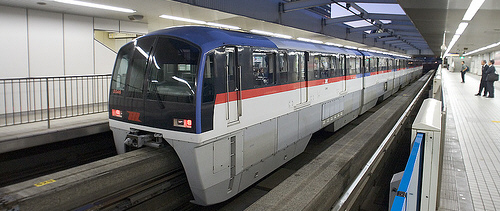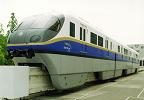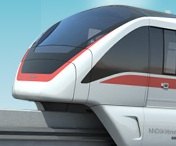Why Monorail?
- Monorails are cost effective. Retrofitting a subway to a crowded city is usually prohibitively expensive. Great uncertainties usually exist as to the full cost of dealing with the myriad underground services (sewers, storm water, mains water, electricity, gas, etc.) as well as geological challenges such as rock and mud. Often subway systems are below sea-level creating many expensive challenges during construction and maintenance. A high-capacity dual-beam Monorail system costs around 10% per km as much as a two-track subway.
- Monorails are proven. Many monorail systems are in use as high-capacity public transport systems carrying thousands of passengers a day at up to 80 km/h. The Tokyo-Haneda monorail (pictured at top of page) transports over a hundred thousand people per day.
- Monorails are safe. Being totally grade-separated monorails are one of the safest forms of transport. Hitachi monorail systems allow train-to-train evacuation and/or evacuation to a walkway. In most cases rescue from a monorail will be easier than rescue from a subway.
- Monorails don't flood. Subway systems are typically below sea-level and so subject to flooding in serious weather event.
- Monorails are independent. A new monorail system would be completely independent of existing transport modes and so unaffected by problems on other networks.
- Monorails can be automated. Bombardier monorails can be driverless with an attendant to provide customer service and security. Other monorail types are suited to automation.
- Monorails are environmentally friendly. As well as having the energy-efficiency of other mass-transit systems, monorails are far less energy-intensive to build than a subway while having a much lower footprint than surface rail. Monorails can be installed with a minimum of disruption on the ground. Monorails have a lower visual impact than other types of elevated rail systems. Monorails can travel at over 80km/h providing an excellent alternative to cars in crowded cities.
- More Express Rail Services. As well as expanding the whole public transport network Monorails can relieve the rail network of some inner city stops allowing rail express services to better service the outer suburbs and regional centres.
 Shadowing from a monorail beam.
Shadowing from a monorail beam. |
 Shadowing from a slab-type elevated transit system.
Shadowing from a slab-type elevated transit system. |
 Monorails take up very little space. (Daegu Monorail, South Korea. Daegu Blog) |
Why Not Monorail?
There are also good reasons to not use a monorail:
- An easement is available: There is no point building a monorail or a subway if a ground level grade-separated easement is available.
- There's no traffic congestion: The roads in the area are not crowded. In this case buses or trams could be used instead.
- Lots of stops are needed: Stops are needed at intervals of less than half a kilometre. This probably means a monorail would not be economic due to the cost of building all the stations unless they could all be hosted in existing buildings.
- No space above ground: In this case a subway may be the only alternative left.
- Government subway costing's are wrong: Some believe the Government estimates of rail subway construction such as those for the $4.9 billion nine kilometre Footscray - Caulfield Metro are completely wrong and the actual cost is 80 to 90% lower than stated. If subway systems really are cheaper than monorails per passenger per kilometre then no problem - subway systems should be built instead.
What is a Monorail?
The Monorail Society defines a monorail as:
| "A single rail serving as a track for passenger or freight vehicles. In most cases rail is elevated, but monorails can also run at grade, below grade or in subway tunnels. Vehicles are either suspended from or straddle a narrow guide way. Monorail vehicles are WIDER than the guide way that supports them." |
Straddle Beam Monorails
On this page we advocate the rubber-tyred straddle-beam (ALWEG) type that are currently used to carry over 100 persons per segment with operating speeds of up to 80km/h in congested urban settings.
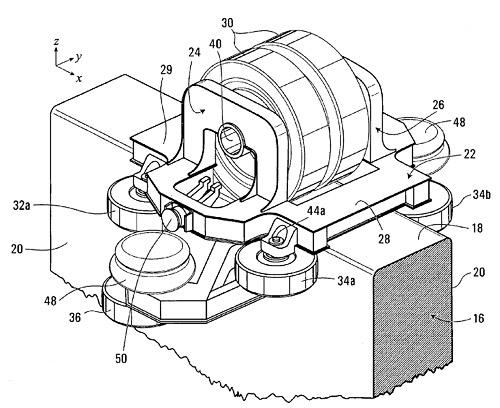
This diagram of the Bombardier Innovia bogie shows how the dual rubber tyres (30) roll on the beam (16) guided by six smaller horizontal tyres (32, 34 and 36). The bogie wheels are either partially (Bombardier) or entirely (Hitachi) under the floor as shown in images on this page.
There are several other monorail types but we do not recommend them for urban mass-transit systems.
Cost
The cost of Hitachi 'Medium' monorails has varied from $27 Million per kilometre for the Okinawa monorail to $73 million per kilometre for the Dubai Palm Jumeirah monorail in 2006.
Compare these numbers with the $500 - $600 million per kilometre quoted in the 2008 Victorian Transport Plan for the new rail subway under Melbourne.
The Monorail Society has an excellent guide to Monorail Cost.
We intend to establish detailed costing's for monorails in Australian cities.
Hitachi Monorail Trains
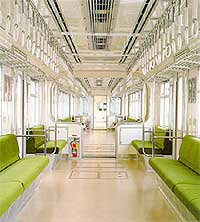 |
Interior of a Hitachi monorail train. Note the wheels are entirely under the floor. The walk-though nature of these carriages is optimised for maximum passenger loading and ease of entering and leaving the carriages. (Image: Hitachi
Rail). |
Hitachi Monorail Types
Hitachi produce three sizes of monorail train:
- Small: About 46 persons per carriage. Maximum speed is 60 km/h. Minimum curve radius is 60m. Length of a 4-car train is 38 meters.
- Medium: About 95 persons per carriage. Maximum speed is 80 km/h. Minimum curve radius is 100m. Length of a 4-car train is 57 meters. These are the world's second largest monorails.
- Large: 110 persons per carriage. Maximum speed is 80 km/h. Minimum curve radius is 100m. Length of a 4-car train is 61 meters. These are the world's largest monorails.
Hitachi Monorail Capacity per Hour
The following is the capacity per hour per direction for eight carriage trains with three minute headway:
- Small: 7,360 passengers / hour / direction.
- Medium: 15,600 passengers / hour / direction. (Recommended for Australian Cities.)
- Large: 18,160 passengers / hour / direction.
Hitachi "Medium" Characteristics
- Length of a 4-car train is 57 meters.
- Width of the carriages is 2.98m compared to 2.650m for a D-Class Siemens tram or 2.92m for a V/Locity train.
- Capacity of about 110 persons per carriage (4 passengers / m2)
- Maximum operational speed is 80 km/h.
- Minimum curve radius is 100m.
- Rail is 1.4m high.
- Monorail Trains may have between two to eight carriages with a claimed minimum headway of 75 seconds.
- Flat floor, walk through layout
- Hitachi monorail trains can be between two to eight carriages long with a suggested headway of three minutes.
- Hitachi has been building monorails since 1962.
- Visit the Hitachi Rail web site for the full technical specifications of their monorail products.
Hitachi Monorail Styling
In recent years Hitachi has produced monorails for a range of cities in several different styles.
Generally the cities where Hitachi monorails have been installed have not been particularly concerned with aesthetics of the pillars which has led to some poor design. In Australia the pillar design would have to be improved.
Naha Osaka Monorail (Japan)
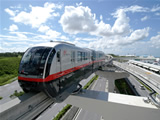 |
This monorail opened in 2003 and has two-carriage monorail trains. (Image: Hitachi
Rail). You can visit the Okinawa monorail on google street view. Walk along under the monorail and see how sharp curves and long spans are handled by Hitachi. We believe we can improve the aesthetics of a monorail system with better stations, improved pillar design and more vegetation under the monorail. |
Chingquing Monorail (China)
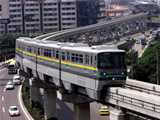 |
This 'Large' Hitachi monorail was opened in 2005 and has four-carriage monorail trains. (Image: Hitachi
Rail) For more images of this spectacular monorail see Skyscraper City. See how this monorail is routed over roads, through buildings and under mountains. |
Palm Jumeirah Dubai Monorail (UAE)
 |
This 'Medium' Hitachi monorail opened in 2009 and has three-carriage monorail trains. (Image: Hitachi
Rail) Track pillars and support rail is the best yet seen for a Hitachi project proving it can be done. |
Recommended Hitachi Monorail for Australia
If Hitachi was selected to provide monorails in Australian cities we recommend using the 'Medium' sized trains in the style of the Osaka monorail.
|
Image of Okinawa monorail adjusted to three carriages. Trains may be up to eight carriages. (Original image: Japanese Wikipedia) |
Bombardier Monorail Trains
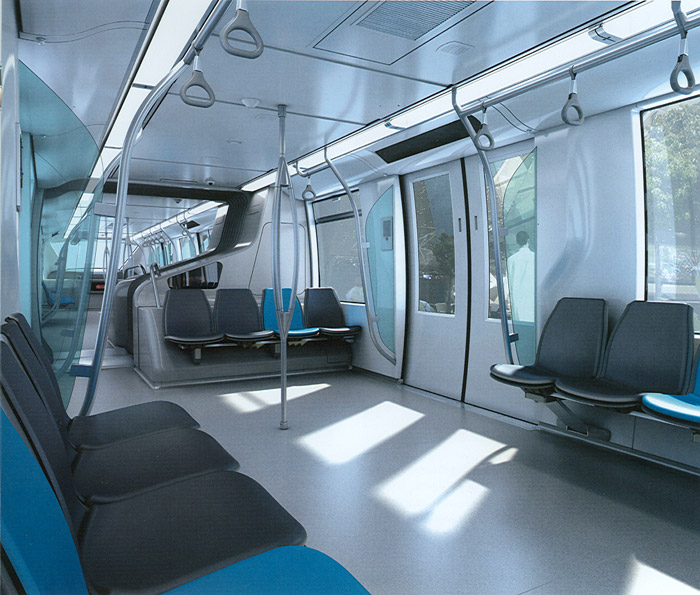 Proposed interior of the Bombardier Innovia 300. (Bombardier Transportation) |
Bombardier "Innovia" Characteristics
- Length of a 4-car train is 50.1 meters.
- Width of the carriages is 3.147m compared to 2.650m for a D-Class Siemens tram or 2.92m for a V/Locity train.
- Capacity of about 90 persons per carriage (4 passengers / m2)
- Maximum operational speed is 80 km/h.
- Minimum curve radius is only 46m.
- Rail is 1.22m high.
- Monorail Trains may have between two to eight carriages with a claimed minimum headway of 75 seconds.
- Flat floor, walk through layout
- Driverless operation is possible.
- Visit the Bombardier site for more information about bombardier's automated monorail 'Innovia 300' and also this PDF. See also The Monorail Society - Innovia Page.
 Art rendering of the Bombardier Innovia 300. (Bombardier Transportation) |
Scomi Monorail Trains
 Scomi of Malaysia also produce monorail trains. |
Scomi Monorail Characteristics
- Length of a 4-car train is 45.5 meters.
- Width of the carriages is 3.0m compared to 2.650m for a D-Class Siemens tram or 2.92m for a V/Locity train.
- Capacity of about 90 persons per carriage (4 passengers / m2)
- Maximum operational speed is 80 km/h.
- Minimum curve radius is 50m.
- Rail is 1.2m high.
- Monorail Trains may have between two to eight carriages with a claimed minimum headway of 75 seconds.
- Walk through layout, but not completely flat-floor.
- Visit the Scomi site for more information. See also the video of a four-carriage Scomi Monorail on their test track.
Aesthetics
|
View Larger Map Street view of Tokyo Monorail near Hamamatsucho station. (Can't see Street View above? Click HERE instead) |
Monorail pillars can be part of a pleasant urban landscape as shown above and on the Monorail Society - Tokyo Trees page featuring the Tokyo-Haneda monorail.

Art rendering of the new monorail track for São Paulo, Brazil. (Original Image: Imgur) |
As the above image shows greater attention is now being paid to the aesthetics of the monorail pillars. We propose that monorail pillars be covered in creepers and that where possible the area under the monorail be a linear garden.
The monorail in Naha, Okinawa is heading in this direction now as can be seen in google street view, although the original pillar design is not as good as in the above image.
For the new Daegu Monorail in South Korea substantial effort has been made to improve the aesthetics of the system as shown below.

Daegu Monorail, South Korea. (Daegu Blog). |
Stations
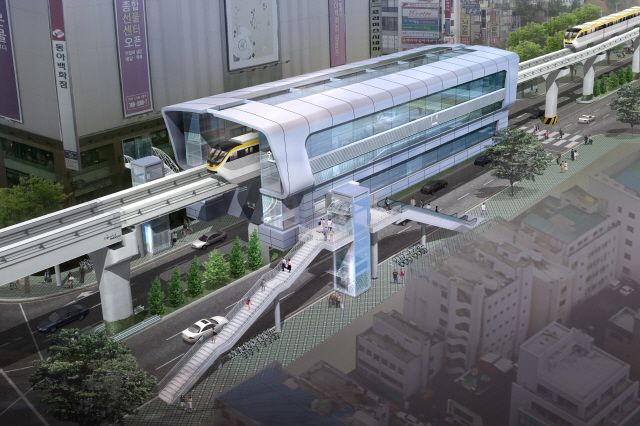
Art rendering of a proposed new monorail station for Daegu, South Korea. Note the very low footprint of the station above the road. Our stations would be more than twice as long as this to cater for eight-carriage trains. |
Our proposed stations would have the tracks in the centre and the platforms on the edge. This means the track components are the same as those used elsewhere on the system. As far as possible the stations themselves would all be of the same design and would be mass produced in modular form to cut costs.
Our proposed stations would be built to allow the maximum length of train which would be 8 carriages, not the three carriage trains shown above. Station size could be reduced slightly by not having doors on the first and last carriages.
All stations would have:
- Highly energy-efficient design to minimise heating and cooling requirements.
- Floor to ceiling platform screen doors.
- Evaporative air-conditioning.
- Solar panels on the roof to assist with the air conditioning and lighting.
- Multiple elevators, escalators and stairs.
- Living walls where possible.
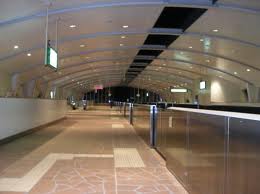
Maihama station, Tokyo (Image: Wikipedia)
Disabled Access
Like any modern subway system, monorail systems are accessed by lift from street level. As lift floor, platform floor and monorail car floors are at the same level there is no impediment to the disabled person using the Monorail. The three meter wide flat floors of the high capacity monorails shown on this page offer improved disabled access compared to most buses and trams.
Safety
Many safety features are built into modern transit monorail systems making them far safer than any of Australia's small tourist monorails.
- A second or third monorail train could be used to evacuate passengers from a stranded or damaged monorail train, although
in practice this has never been necessary. (Note that evacuation via the front of the monorail is only feasible with Hitachi
designs as they have doors at the front and rear.)
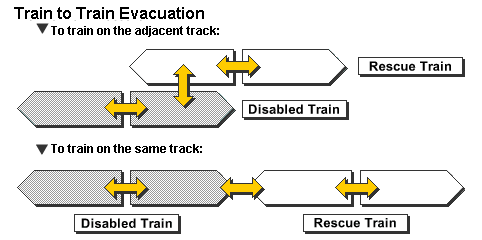
- Some monorails have walkways along much of the monorail track suspended between the beams. We recommend this as an additional safety feature. Ladders to reach the walkway could easily be carried on the train but carriage-to-carriage rescue would be a better option.

- Emergency stairs would be placed at intervals along the monorail line (especially low-points) that would allow passengers to exit to the ground from the above walkway in the event of an unexpected stop.
- All the recommended monorail designs allow passage between carriages for all passengers including those in a wheel chair. We recommend fire-resistant doors be fitted to trains to allow some partitioning of the train. We also recommend large CO2 extinguishers be carried on the trains.
- Elevated rail systems are inherently safer than subway systems due to the speed at which most elevated trains can be reached from the ground compared to stranded subway vehicles deep in the ground.
- Passengers on a burning elevated monorail train are less likely to be overcome with smoke and fumes than passengers on a burning subway car, especially if fire doors were fitted to the monorail.
- Where monorail pylons are located on or near road or rail lines they should be built to withstand substantial impacts without collapse.
- If monorail beams were to cross roads with a height clearance less than other existing infrastructure then a protecting beam should be placed across the road ahead of the monorail beam.
- The monorail should draw power at multiple points and have regular back-up generators capable of at least moving the monorail carriages to the next station.
Monorail Myths & Misconceptions
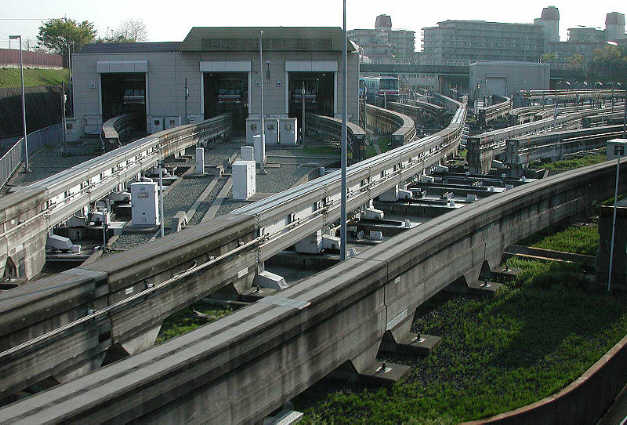
Switches at the storage facility of Osaka Monorail. (Monorail Society). |
- Monorails switches are a problem. One of the more persistent myths about monorails is that there is a problem with switches. In reality all commuter transit monorails use switches as much as conventional rail systems. For more on monorail switches (including videos) see The Monorail Societies Switch Myth page.
- Monorails can't run at ground level. The above picture shows a monorail running just above ground level. The whole point of a monorail is that there is no space for a ground level transit system.
- With Monorails you can't have level crossings. Surely the dumbest of dumb criticisms! Monorails are built so you don't have any level crossings.
- Monorails can't go through tunnels. Many monorails run through tunnels for part of their length due to the difficult terrain. Examples are Tokyo and also Chongqing in China. Chongqing monorail has several underground stations.
- Monorails are not standardized. This means care needs to be taken to avoid being locked into one manufacturer's product indefinitely. In reality these Monorails are not that high-tech and a wide range of manufacturers could build new monorail carriages to fit on any particular track.
- Monorails are slow. 90kmh is suitable for a transit system.
- Monorails are low capacity. Large Hitachi monorails carry 900 passengers in a six-car train. The Tokyo monorail has carried millions of commuters for decades.
Urban Monorail Videos
A Stylish New Monorail
This video shows how a Bombardier monorail could be rolled out over congested roads to provide new public transport.
|
A June 2011 Bombardier presentation to the City of Rio de Janeiro for an integrated transit project in Barra da Tijuca featuring a monorail that would be ready for the 2016 Olympic games. |
A Workhorse Utility Monorail
The Tokyo-Haneda monorail has proven how useful a monorail can be over four decades of profitable and reliable service.
Much imagination is required to picture a similar monorail travelling over a landscaped 'treeway' in an Australian city instead of the concrete jungle of Tokyo. That said, there is one section below this monorail that is landscaped. This can be seen on Monorail Society - Tokyo Trees page.
|
A ride in from Haneda Airport to Hamamatsucho terminal through a bleak and congested Tokyo. This is a 'workhorse' utility monorail that carries hundreds of thousands of passengers per year. (Video by Rocketboy1950) |
Track Design for Australian Monorails
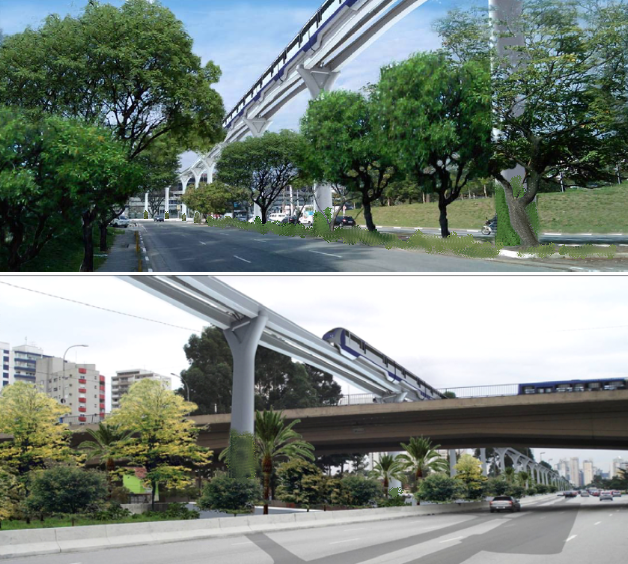
Art rendering of monorail track suitable for Australian cities. (The original Image was for the new monorail in São Paulo, Brazil: Skyscraper City) |
- Double Track: In all cases double track is recommended. As with any rail system having a single track places severe limitations on service frequency. In the case of monorail the savings from having a single track are limited and space is unlikely to be an issue. It is possible that in some case the left and right tracks could be routed on either side of some obstacle for a short distance. In the CBD it may be useful to have a split station hosted on buildings on opposite sides of the street.
- 30 meter column spacing. In general the maximum spacing for column supporting concrete beams would be used which is 30 meters. Greater spans require use of steel beams or concrete beams supported by steel.
- Guide rails: These will be arched as used on the Dubai and São Paulo monorails. The pre-cast guideway sides and base will have a polished 'class-1' finish. The top of the guideway is finished so as to provide adequate grip for the tyres.
- Pillars: The pillars are 1.2 meters in diameter and will have a high quality finish. See images of the São Paulo Monorail (under construction). Pillars will be sized to ensure at least 4.3 meter clearance over all major roadways. Power and other cabling will be run up a hollow central core.
- Pillar Base Guard: The base of the column will be fitted with a non-structural guard to absorb vehicle impacts. (The pillar itself goes through the guard into the ground.) The guard will come in two halves to allow replacement if damaged. The colouring and finish is yet to be determined, but would not be grey.

- Vertical Gardens: We recommend all support columns and stations are installed with extensive vegetation covering most of the vertical surfaces to create
living walls.
This is both to improve aesthetics of the pillars and to discourage
vandalism.

The climbing fig Ficus pumila (Wikipedia) - Tree Way: As shown in the above examples a "tree way" will be created underneath the monorail track wherever possible. Where trees are already present as many as possible will be retained and additional plantings created.
Monorail Guideway Standards
Australia's rail system has been adversely impacted by the adoption of various rail gauges across the continent. A similar mistake can be made with straddle beam Monorails.
The objective is to have a standard monorail guideway adopted for all Monorails.
In selecting particular technologies and providers:
- A single guideway type for Urban Transit Monorails should be selected for each City if not the whole country.
- At the point of selection the selected manufacturer would have to agree to reasonable licence fees for their technology to be used going forward if they wish their technology to be the standard for the State if not Australia.
- The selected manufacturer would also need to agree for others to manufacturer monorail vehicles or guideway of the agreed guideway standard should the selected manufacturer cease to exist.
Minimal Advertising
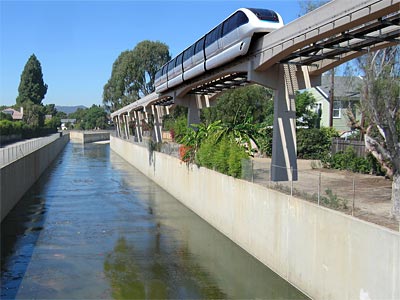
Artists impression of an LA monorail running over the flood channels. (http://lavisions.blogspot.com.au) |
It is suggested that Monorail trains, stations and pillars carry minimal advertising.
This needs to be written in to key contract documents to prevent future operators covering monorail infrastructure with unsightly billboards which would degrade the aesthetics of the system. This would still leave open the possibility of selling naming rights on each train which would allow the name and logo of the sponsoring company appearing on the train.
Under the Track
Wherever possible a 'treeway' will be planted underneath the monorail track. Along many suggested routes trees are already in place, in this case every effort would be made to retain as many trees as possible.
|
View Larger Map Street View of Naha Monorail, Okinawa. We aim to have more aesthetic pillars in place for Australian monorails. (If Street View does not display then click HERE and click street view.) |
Long Spans
Hitachi used braced steel girders to support the track through over long sections without pillars and for tight curves track for it's Okinawa Monorail.
|
View Larger Map Street View of Naha Monorail, Okinawa showing a long curved span. (If Street View does not display then click HERE and click street view.) |
Offset Guideway Support
Offset track can be used where a central pillar is impractical further increasing design flexibility.

Modified image of Okinawa monorail (Hitachi system). |
Automation
Monorails are well suited to automatic driving due to the lack of any level crossings, pedestrians or other unpredictable interruptions.
However it is anticipated that trains would generally carry at least one crew member to perform the following tasks:
- Safely closing the doors and starting the train towards the next station.
- Providing security and discouraging vandalism.
- Providing First Aid to ill passengers.
- Emergency management.
During late night or early morning operations these functions may on occasions be performed by remote control from a command room. At these times only accredited passengers may use the system.
Train automation systems will not be connected to the internet at any time.
Capacity
Capacity depends on the time between services, the number of carriages and the loading per square meter. Loading Capacity (Passengers per hour per direction) can then be calculated.
The following data is from Hitachi Rail for their medium-sized monorail product with a loading of four person's per square meter which would be considered the maximum loading in Australia.
Note that the system can be expanded over time. Initially two-car trains could be used at 10 minute intervals and then gradually ramped up to eight-car trains every three minutes.
Eight-carriage trains would be about 100 meters long.
Passengers per hour per direction
| Headway (min) |
No. of Trains (per hour) |
2-Car Train | 3-Car Train | 4-Car Train | 8-Car Train |
|---|---|---|---|---|---|
| 3 | 20 | 3,680 | 5,740 | 7,800 | 15,600 |
| 4 | 15 | 2,760 | 4,305 | 5,850 | 11,700 |
| 5 | 12 | 2,208 | 3,444 | 4,680 | 9,360 |
| 6 | 10 | 1,840 | 2,870 | 3,900 | 7,800 |
The Monorail Alternative Submission
In 2008 the Victorian State Government announced its intention to spend $16.5 billion building:
- A road tollway under Melbourne from East to West.
- A rail subway from Footscray to Caulfield.
As part of the process the government called an "East West Link Needs Assessment Enquiry" and called for public submissions.
NewAustralia submitted a "Monorail Alternative" submission with assistance from Hitachi Rail. (The NewAustralia web site is owned by Monorails Australia.)

NewAustralia's East - West Monorail Submission.
Other Monorail Types
There are a range of other monorail types including:
- Double Flanged Monorails: The first known rail system built with one rail was built in Wuppertal, Germany, in 1901. This system has large gantries that support an overhead rail that the monorail vehicle hangs from. This system is of historical interest but we would not recommend it in Australia.
- SAFEAGE Monorails: These are suspended from above as shown in the image below. We believe the support structures for these monorails are too visually intrusive for Australian cities. Additionally this type has limited evacuation options in the event of a problem on the vehicle.
 Shonan SAFEAGE Monorail (Pazhayathu.blogspot.com.au) |
Australia's Small Tourist Monorails
Australia has some experience with small tourist monorails. While these are tiny compared to the large commuter monorail systems we are talking about on this site they have operated fairly successfully in their designated roles.
These monorails do not allow passengers to move from carriage to carriage through the train. In our view this creates an unacceptable safety risk for passengers in the event of fire or other problems on the monorail vehicle.
We do not recommend these types of small monorail.
- Sydney's Metro Monorail. The Sydney monorail carried 4 million passengers per annum around its short loop of track despite only seating 48 passengers per train. The plan to replace it with a tram service seems odd given the complete lack of space for trams in Sydney's streets. There is some talk of it being re-built in Hobart or elsewhere.
- The Seaworld Monorail. This monorail suffers from travelling at below walking pace and having doors that must be manually opened one at a time by the driver!
- The Oasis-Broadbeach Monorail at Broadbeach.
